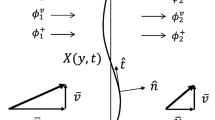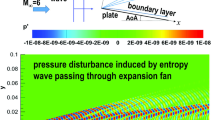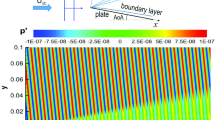Abstract
The hypersonic boundary-layer receptivity to slow acoustic waves is investigated for the Mach 6 flow over a 5-degree half-angle blunt cone with the nose radius of 5.08 mm. The plane acoustic wave interacts with the bow shock, and generates all types of disturbances behind the shock, which may take various routes to generate the boundary-layer unstable mode. In this paper, two routes of receptivity are investigated in detail. One is through the disturbance in the entropy layer. The other is through the slow acoustic wave transmitted downstream the bow shock, which can excite the boundary-layer mode due to the synchronization mechanism. The results show that, for a low frequency slow acoustic wave, the latter route plays a leading role. The entropy-layer instability wave is able to excite the first mode near the neutral point, but its receptivity efficiency is much lower.
Similar content being viewed by others
Abbreviations
- Ma :
-
Mach number
- Re 1 :
-
unit Reynolds number
- Re :
-
Reynolds number
- ρ :
-
density
- u :
-
stream-wise velocity
- v :
-
normal velocity
- T :
-
temperature
- p :
-
pressure
- φ :
-
cone half-angle
- γ :
-
specific heat ratio
- Pr :
-
Prandtl number
- t :
-
time
- x,y :
-
axial and radial coordinates
- ξ,η :
-
stream and normal coordinates
- s :
-
cone surface location
- U :
-
vector of the flow variable
- E :
-
convective flux in the axial direction
- F :
-
convective flux in the radial direction
- E v :
-
viscous heat conduction flux in the axial di-rection
- F v :
-
viscous heat conduction flux in the radial-direction
- M :
-
source term
- τ ij :
-
shear stress
- q i :
-
heat flux
- e s :
-
total internal energy
- μ :
-
viscosity coefficient
- κ :
-
heat conductivity coefficient
- A :
-
amplitude
- α :
-
stream-wise wavenumber
- ω :
-
angular frequency
- i:
-
imaginary unit
- c.c.:
-
conjugate complex
- ∞:
-
free stream
- w:
-
wall
- ′:
-
disturbance
References
MACK, L. M. Boundary layer linear stability theory. AGARD Special Course on Stability and Transition of Laminar Flow, Belgium (1984)
ZHU, Y. D., CHEN, X., WU, J. Z., CHEN, S. Y., LEE, C. B., and MOHAMED, G. H. Aerodynamic heating in transitional hypersonic boundary layers: role of second-mode instability. Physics of Fluids, 30, 011701 (2018)
SARIC, W. S., REED, H. L., and KERSCHEN, E. J. Boundary layer receptivity to freestream disturbances. Annual Review of Fluid Mechanics, 34, 291–319 (2002)
FEDOROV, A. V. Transition and stability of high-speed boundary layers. Annual Review of Fluid Mechanics, 43, 79–95 (2011)
ZHONG, X. and WANG, X. Direct numerical simulation on the receptivity, instability, and transition of hypersonic boundary layers. Annual Review of Fluid Mechanics, 44, 527–561 (2012)
JIANG, X. Y. and LEE, C. B. Review of research on the receptivity of hypersonic boundary layer (in Chinese). Journal of Experiments in Fluid Mechanics, 31, 1–11 (2017)
CHEN, J. Q., TU, G. H., ZHANG, Y. F., XU, G. L., YUAN, X. X., and CHEN, C. Hypersonic boundary layer transition: what we know, where shall we go (in Chinese). Acta Aerodynamica Sinica, 35, 311–337 (2017)
BALAKUMAR P. and CHOU, A. Transition prediction in hypersonic boundary layers using receptivity and freestream spectra. AIAA Journal, 56, 193–208 (2018)
CHU, B. T. and KOVASZNAY, L. S. G. Non-linear interactions in a viscous heat-conducting compressible gas. Journal of Fluid Mechanics, 3, 494–514 (1958)
MASLOV, A. A., SHIPLYUK, A. N., SIDORENKO, A. A., and ARNAL, D. Leading-edge re-ceptivity of a hypersonic boundary layer on a flat plate. Journal of Fluid Mechanics, 426, 73–94 (2001)
MA, Y. and ZHONG, X. Receptivity of a supersonic boundary layer over a flat plate: part 1, wave structures and interactions. Journal of Fluid Mechanics, 488, 31–78 (2003)
MA, Y. and ZHONG, X. Receptivity of a supersonic boundary layer over a flat plate: part 2, receptivity to free-stream sound. Journal of Fluid Mechanics, 488, 79–121 (2003)
MA, Y. and ZHONG, X. Receptivity of a supersonic boundary layer over a flat plate: part 3, effects of different types of free-stream disturbances. Journal of Fluid Mechanics, 532, 63–109 (2005)
EGOROV, I., FEDOROV, A., and SOUDAKOV, V. Direct numerical simulations of supersonic boundary layer receptivity to scoustic disturbances. 43rd AIAA Aerospace Sciences Meeting and Exhibit, AIAA 2005–0097, Nevada (2005)
ZHONG, X. and MA, Y. Boundary layer receptivity of Mach 7.99 flow over a blunt cone to free-stream acoustic waves. Journal of Fluid Mechanics, 556, 55–103 (2006)
KARA, K., BALAKUMAR, P., and KANDIL, O. Receptivity of hypersonic boundary layers due to acoustic disturbances over blunt cone. 45th AIAA Aerospace Sciences Meeting and Exhibit, AIAA 2007–0945, Nevada (2007)
BALAKUMAR, P. and KEGERISE, M. A. Receptivity of hypersonic boundary layers to acoustic and vortical disturbances. 49th AIAA Aerospace Sciences Meeting including the New Horizons Forum and Aerospace Exposition, AIAA 2011–371, Florida (2011)
BALAKUMAR, P. Receptivity of hypersonic boundary layers to acoustic and vortical disturbances (invited). 49th AIAA Fluid Dynamics Conference, AIAA 2015–2473, Texas (2015)
SEMIONOV, N. V. and KOSINOV, A. D. An experimental study of receptivity of supersonic boundary layer on a blunted plate. International Journal of Mechanics, 2, 87–95 (2008)
FEDOROV, A. V. and KHOKHLOV, A. P. Excitation of unstable modes in a supersonic boundary layer by acoustic waves. Fluid Dynamics, 26, 531–537 (1991)
FEDOROV, A. V. and KHOKHLOV, A. P. Excitation and evolution of unstable disturbances in supersonic boundary layer. Proceeding of the ASME Fluids Engineering Conference, Washington D.C., 1–13 (1993)
FEDOROV, A. V. and KHOKHLOV, A. P. Prehistory of instability in a hypersonic boundary layer. Theoretical and Computational Fluid Dynamics, 14, 359–375 (2001)
FEDOROV, A. V. Receptivity of high speed boundary layer to acoustic disturbances. Journal of Fluid Mechanics, 491, 101–129 (2003)
MCKENZIE, J. F. and WESTPHAL, K. O. Interaction of linear waves with oblique shock waves. Physics of Fluids, 11, 2350–2362 (1968)
ROBINET, J. C. and CASALIS, G. Critical interaction of a shock wave with an acoustic wave. Physics of Fluids, 13, 1047–1059 (2001)
SU, C. H. and GENG, J. L. Interaction of weak free-stream disturbance with an oblique shock: validation of the shock-capturing method. Applied Mathematics and Mechanics (English Edition), 38(11), 1601–1612 (2017) https://doi.org/10.1007/s10483-017-2279-9
DIETZ, G. and HEIN, S. Entropy layer instabilities over a blunted flat plate in supersonic flow. Physics of Fluids, 11, 7–9 (1999)
STETSON, K. F., THOMPSON, E. R., DONALDSON, J. C., and SILER, L. G. Laminar bound-ary layer stability experiments on a cone at Mach 8, part 2: blunt cone. 22nd Aerospace Sciences Meeting, AIAA 84–0006, Nevada (1984)
JIANG, G. S. and SHU, C. W. Efficient implementation of weighted ENO schemes. Journal of Computational Physics, 126, 202–228 (1996)
WAN, B. B. and LUO, J. S. Entropy layer instability over a blunt plate in supersonic flow (in Chinese). Acta Aerodynamica Sinica, 36, 247–253 (2018)
KENDALL, J. M. Wind tunnel experiments relating to supersonic and hypersonic boundary layer transition. AIAA Journal, 13, 290–299 (1975)
STETSON, K. F., KIMMEL, R. L., THOMPSON, E. R., DONALDSON, J. C., and SILER, L. G. A Comparison of planar and conical boundary layer stability and transition at a Mach number of 8. 22nd Fluid Dynamics, Plasma Dynamics and Lasers Conference, AIAA 91–1639, Hawai (1991)
GRAZIOSI, P. and BROWN, G. L. Experiments on stability and transition at Mach 3. Journal of Fluid Mechanics, 472, 83–124 (2002)
MACK, L. M. Linear stability theory and the problem of supersonic boundary layer transition. AIAA Journal, 13, 278–289 (1975)
ESTORF, M., RADESPIEL, R., SCHNEIDER, S., JOHNSON, H. B, and HEIN, S. Surface-pressure measurements of second-mode instability in quiet hypersonic flow. 46th AIAA Aerospace Sciences Meeting and Exhibit, AIAA 2008–1153, Nevada (2008)
ALBA, C., CASPER, K., BERESH, S., and SCHNEIDER, S. Comparison of experimentally measured and computed second-mode disturbances in hypersonic boundary layers. 48th AIAA Aerospace Sciences Meeting Including the New Horizons Forum and Aerospace Exposition, AIAA 2010–897, Florida (2010)
KING, R. A., CHOU, A., BALAKUMAR, P., OWENS, L. R., and KEGERISE, M. A. Measurements in a transitioning cone boundary layer at freestream Mach 3.5. 54th AIAA Aerospace Sciences Meeting, AIAA 2016–0050, California (2016)
Acknowledgements
The first author and the third author are grateful to Prof.Heng ZHOU of Tianjin University for the stimulating discussion and tremendous support on this work. The third author would like to thank Prof.Xuesong WU of Imperial College for his continuous encouragement and inspiring discussion. Special thanks to Dr. Lei ZHAO from Tianjin University for generously providing his DNS codes for the current computations.
Author information
Authors and Affiliations
Corresponding author
Additional information
Project supported by the National Natural Science Foundation of China (Nos. 11472188 and 11332007) and the National Key Research and Development Program of China (No. 2016YFA0401200)
Rights and permissions
About this article
Cite this article
Wan, B., Luo, J. & Su, C. Response of a hypersonic blunt cone boundary layer to slow acoustic waves with assessment of various routes of receptivity. Appl. Math. Mech.-Engl. Ed. 39, 1643–1660 (2018). https://doi.org/10.1007/s10483-018-2391-6
Received:
Revised:
Published:
Issue Date:
DOI: https://doi.org/10.1007/s10483-018-2391-6




